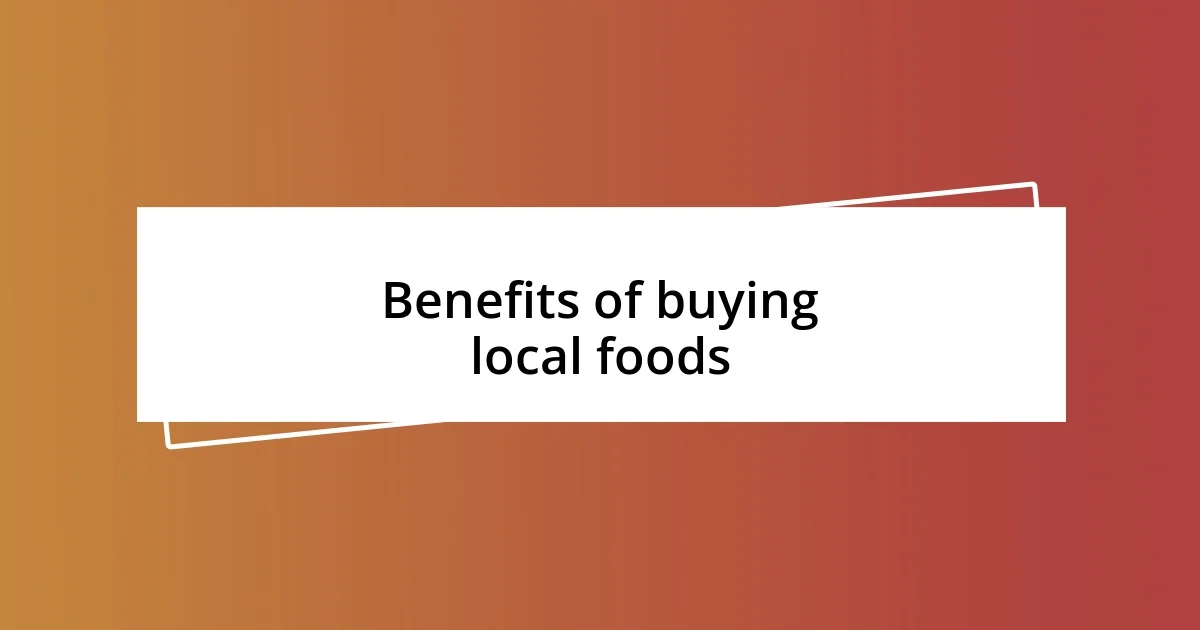Key takeaways:
- Local food markets offer a rich cultural and social experience, connecting consumers to farmers, traditions, and community spirit.
- Buying local foods supports the economy, ensures freshness, and reduces environmental impact while fostering a deeper appreciation for food.
- Engaging with local farmers enhances the shopping experience through personal connections and encourages sustainable practices, benefiting both the community and the environment.

Exploring local food markets
When I first stepped into a local food market, it was like diving into a vibrant tapestry of flavors and colors. Stalls brimming with fresh produce, aromatic herbs, and artisanal products beckoned me, each tempting me to sample something new. I often wonder, how can one experience so many distinct cultures in a single afternoon?
Engaging with local farmers and vendors has opened my eyes to the hard work and dedication behind each product. I vividly recall chatting with a honey producer, who passionately shared stories about the bees and their role in maintaining our ecosystem. It made me realize how investing in local food means supporting not just the economy, but also the community and the environment.
Every visit to a local market feels like a treasure hunt for unique, seasonal ingredients. I can still taste the burst of ripe heirloom tomatoes I found one summer. They reminded me that food is not just sustenance; it’s a connection to the land and a reflection of the seasons. Do you remember the last time a simple ingredient surprised you with its incredible flavor? That’s the magic local markets bring—they offer discoveries that nourish both the body and the soul.

Understanding market culture
Understanding the culture of local food markets is fascinating. Each market reflects the unique stories and traditions of its community. I still remember a chilly morning spent at a market, when a vendor smiled warmly and told me about the age-old farming methods his family has used for generations. That connection to heritage made the vegetables he sold feel even more special.
As I wandered through the various stalls, I couldn’t help but notice how these markets serve as social hubs. I once found myself joining a spontaneous conversation among regulars about a new recipe someone had tried with a local ingredient. It was great to see how sharing food not only brings people together but also strengthens community bonds. Have you ever felt that sense of belonging in a place filled with strangers?
The atmosphere pulsates with excitement and familiarity, making every visit feel like a reunion. I recall one Saturday, overhearing the joyful laughter of children eagerly choosing fresh fruits. It reminded me how local markets cultivate not just commerce, but also the essence of community spirit. They create a cultural lifeline where food transcends beyond the plate and becomes a shared experience.
| Aspect | Description |
|---|---|
| Tradition | Each market showcases the heritage and farming practices unique to its region. |
| Community | Markets act as social gathering spots, fostering connections among vendors and customers. |
| Experience | Visiting local markets provides emotional engagement and a sense of belonging. |

Benefits of buying local foods
Buying local foods brings enormous benefits that resonate deeply with my values. One of the most significant advantages I’ve noticed is the superior freshness of the produce. Just last month, I bought strawberries directly from a local farm. The experience was a stark contrast to grabbing a pint from the grocery store. These strawberries, plump and bursting with flavor, reminded me that food should be an experience rather than just a routine purchase.
- Supports the Local Economy: Investing in local food strengthens community businesses, ensuring that more of your money stays within the local area.
- Freshness and Flavor: Local foods typically don’t have to travel far, leading to fresher, tastier products that are often harvested at their peak.
- Reduced Environmental Impact: Supporting local farmers means shorter transportation routes, which reduces carbon footprints and helps combat climate change.
Furthermore, buying local fosters a unique relationship with the people who grow our food. During one of my visits to a farmer’s market, I was struck by the pride in a farmer’s voice as he described how he’d nurtured his heirloom squash. His enthusiasm not only made me appreciate my purchase more but also created a bond between us. When you know the story behind your food, it transforms a simple meal into a celebration of local culture and craftsmanship.
- Connection to Food Sources: Engaging with local vendors allows consumers to understand where their food comes from, often leading to healthier choices.
- Seasonal Eating: Local markets encourage eating in harmony with the seasons, promoting diverse diets and sustainable practices.
- Encouragement for Sustainable Practices: Many local farmers embrace organic or regenerative farming, which helps preserve the environment and promote biodiversity.
In essence, buying local is about more than just food; it’s a way of life that cultivates community, nurtures the environment, and elevates our everyday experiences. Each trip to the market feels personal and invigorating, reminding me that our choices can have far-reaching effects.

Tips for selecting fresh produce
When you’re selecting fresh produce, look for vibrancy and color. I’ve learned that the ripest fruits and vegetables often stand out with their bright hues. For instance, I once reached for some bell peppers that practically glowed in the afternoon sun. That day, the sweet crispness of those peppers taught me to always trust my eyes—they rarely lead me astray.
Another tip is to familiarize yourself with the seasons. Knowing what’s in season not only enhances freshness but also flavor. I still remember biting into a juicy tomato in late summer and realizing how different it tasted compared to a winter variety. Have you ever asked a vendor about when their products were harvested? Those conversations often guide me toward the best selections, revealing which items are at their peak.
Don’t shy away from asking questions. Engaging with the sellers has delivered some of my best discoveries. One time, I learned that the beautiful kale I was eyeing was not only organic but also grown just a few miles away. That personal connection made me appreciate my purchase even more, transforming a simple green into a part of my community. So, remember, your curiosity can lead to surprising and rewarding finds!

Engaging with local farmers
Engaging with local farmers has been one of the most enriching parts of my experience at food markets. I remember chatting with an elderly farmer who shared stories of growing heirloom tomatoes. His passion was palpable, and it struck me how these conversations bring the food to life and forge a real connection to my plate. Have you ever tasted something and wondered about its journey? Knowing the farmer’s dedication makes every bite feel like a tribute to their hard work.
What I find fascinating is how these interactions often lead to unexpected delights. Once, after discussing sustainable practices, a farmer suggested a rare variety of zucchini I had never seen before. Intrigued, I took a leap and cooked it that evening. The vibrant green color and unique taste transformed a simple dish into something extraordinary. Isn’t it incredible how a personal recommendation can introduce us to new flavors?
The beauty of engaging with local farmers extends beyond just the products—they embody a commitment to our community and the environment. I’ve grown to appreciate the seasonal rhythms of their offerings, learning firsthand what to expect throughout the year. The thrill of discovering fresh strawberries in spring always reminds me of the joys of anticipation and gratitude. Connecting with farmers has not only deepened my understanding of food but also inspired me to be more mindful of the choices I make in my kitchen.

Creating a balanced meal plan
Creating a balanced meal plan is about more than just food choices; it’s a way of thinking about nourishment holistically. I vividly recall the first time I mapped out my weekly meals based on what I found at a local market. I stood in front of a stall, scanning colorful veggies and fresh herbs, and suddenly it hit me: my meals could be vibrant and varied, reflecting the seasons and my cravings. Have you ever felt overwhelmed by the endless meal planning apps and diets? I’ve learned that simplicity often leads to sustainability.
In my experience, incorporating different food groups while keeping it practical is key. I once mixed some hearty grains like quinoa with roasted veggies and a sprinkle of feta, creating a dish that was not only filling but also exciting to eat. The nutty flavor of the quinoa paired with the sweet roasted carrots was a reminder that balanced meals don’t have to be boring. Can you recall a time when a simple dish surprised you? For me, it’s those moments that cultivate a deeper appreciation for what we eat.
Planning meals around local produce has also taught me to embrace flexibility. Sometimes, I go to the market with a specific recipe in mind, only to be inspired by what’s available. Each time I adjust my plan, I find joy in the process—like when I subbed fresh basil for a wilted herb at home, instantly elevating my pasta dish. Isn’t it rewarding to let fresh ingredients guide our culinary creativity? By doing so, I’ve discovered that a balanced meal plan is as much about adaptability as it is about nutrition.

Supporting community through local food
When I think about supporting my community through local food, I recall the feeling of unity at the neighborhood farmers’ market. Recently, I volunteered to help set up the stalls, and the buzz of laughter and conversation was contagious. It struck me how these markets aren’t just about buying produce; they create a space where relationships flourish and locals come together. Have you ever felt that sense of connection just by being part of a community event?
I also appreciate how local food can spark economic growth in our area. I remember chatting with a small bakery owner who started her business right at the market. She shared how selling her freshly baked bread allowed her to hire local artisans and support other small businesses nearby. Hearing her story made me realize that every dollar spent on local food is an investment in our shared future. Isn’t it empowering to know that our choices can directly impact our neighbors’ livelihoods?
Attending local food markets has made me increasingly aware of the importance of sustainability within our community. One time, I stumbled across a booth focused on reducing food waste. The vendor offered tips on how to repurpose scraps into delicious meals, and I left feeling inspired to cut down on my waste. Learning about how our food choices can benefit the environment adds yet another layer of significance to supporting local food. It makes you wonder: how can we all contribute to a greener future in our own towns?














